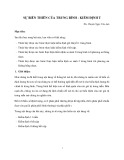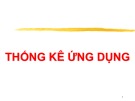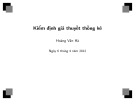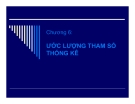
Gs, TS LÊ HOÀNG NINH
Th ng kê mô tố ả
Căn B n v sinh th ng kêả ề ố

N i dung c n phân bi t ộ ầ ệ
•Distinguish between different strategies
for obtaining a sample from a population
•Understand the measures of central
tendency and variability in your data
2

Th ng kê mô t và suy lýố ả
Th ng kê mô tố ả: dùng các con s đ t ch c, ố ể ổ ứ
bi u th m t b d li u t m t m u.ể ị ộ ộ ữ ệ ừ ộ ẫ
Th ng kê suy lý:ố có m t k t lu n t thông tin ộ ế ậ ừ
ch a hoàn chi3ng, nghĩa là t ng quát hóa k t ư ổ ế
qu t m t m u lên qu n th . ả ừ ộ ẫ ầ ể
Inferential statistics use available information in
a sample to draw inferences about the
population from which the sample was selected

Qu n th lý thuy tầ ể ế
Sample 1:
Sample 2:
Sample 3:
Representative? Y N
Representative? Y N
Representative? Y N
4

Cách l y m uấ ẫ
•Convenience Sampling: select the most
accessible and available subjects in target
population. Inexpensive, less time consuming,
but sample is nearly always non-representative
of target population.
•Random Sampling (Simple): select subjects at
random from the target population. Need to
identify all in target population first. Provides
representative sample frequently.
5



![Bài giảng Thống kê thực hành [Chuẩn SEO]](https://cdn.tailieu.vn/images/document/thumbnail/2015/20151118/codon_01/135x160/4141447817381.jpg)





















![Quyển ghi Xác suất và Thống kê [chuẩn nhất]](https://cdn.tailieu.vn/images/document/thumbnail/2025/20251030/anh26012006/135x160/68811762164229.jpg)
